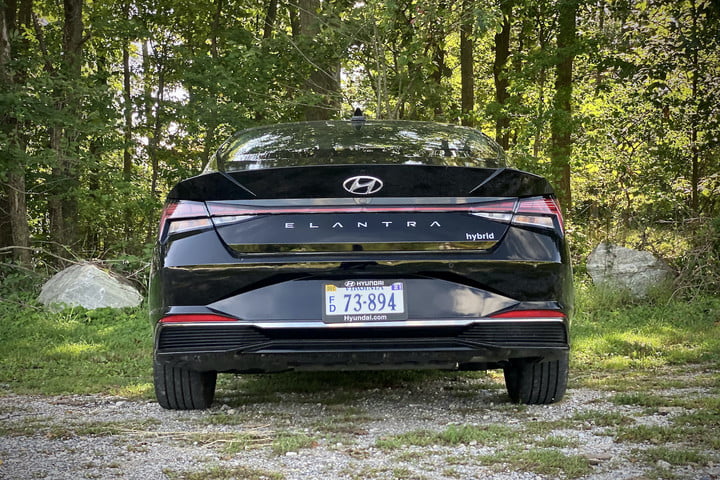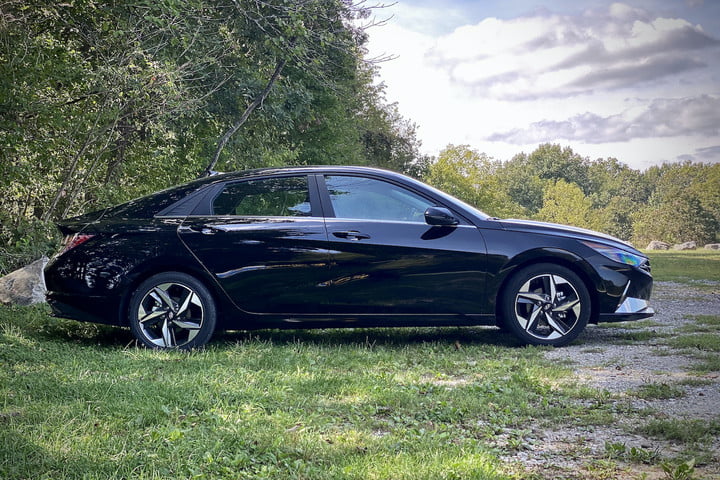At one point, the Toyota Prius was the only hybrid you could get if you were looking for seriously good fuel economy. Of course, that’s not the case anymore, as fuel-efficient hybrids come in all shapes and sizes these days. If you check the EPA’s charts, you’ll notice that the Prius isn’t the king of the hybrids as it once was. No, the crown now sits on the Hyundai Ioniq Blue’s hood. Hyundai’s taking its electrified knowledge and putting it into the 2021 Elantra Hybrid.
Sure, the Elantra Hybrid isn’t as efficient as the Ioniq or the Prius, but it makes up for it with styling that won’t make you nauseous, some impressive tech features, and an interior you’ll actually want to spend time in. Sometimes, you can have your cake and eat it, too. Just like any halfway decent cake from a reputable bakery, you’re going to spend a decent amount of money getting something that’s this sweet.
To get into a 2021 Elantra Hybrid, you’re looking at spending $24,575 with a mandatory $1,025 destination fee. That’s a hefty upgrade over the regular Elantra that costs $20,675. Our test vehicle was a Limited model that rang in at $29,125.
Design and interior
Mainstream automakers can’t seem to find a happy medium with hybrids. Some, like the Toyota Prius and Hyundai Ioniq, have odd designs in the name of aerodynamics, while others like the Honda Insight and Toyota Corolla Hybrid skew to being safe. The Elantra Hybrid bucks the trend of needing a slippery design and says no to being boring for something that feels upscale and distinctive.

The Elantra Hybrid’s wow factor, as with many other Hyundais, starts at the front. The compact sedan’s angular noise features a unique grille with an intricate design that looks like it was completed by Spider-Man and swept-back headlights that travel far up the hood. The doors have angular lines that connect with one another to look like a modern piece of art. None of these qualities are as noteworthy as the rear end, though. It’s as angular as a venomous snake’s triangular head with taillights that are just as menacing as the reptile’s eyes.
The interior is equally attractive as it is high-tech. The digital instrument cluster and central touchscreen are connected in a way that wraps around the driver. The dashboard and center console layout follow a similar curve, making controls easier to reach for the driver.
While the overall design of the Elantra Hybrid is upscale and most of the materials are pleasant, there’s one major thing that will make you pause. The instrument cluster and touchscreen look nice, but there’s a large blank spot to the left of the driver that has a random design on it. It’s an odd element in a package that looks as nice as the Elantra Hybrid.
As we’ve all come to expect from Hyundai, the Elantra Hybrid comes packed with features. Leather upholstery, heated and ventilated front seats, a sunroof, ambient interior lighting, and lumbar support for the driver’s seat are standard on the Limited trim we tested. No denying that these are nice features to have, but Hyundai should’ve spent some more time adding cushioning to the bottom of the front seats. On a long drive, your bum will go numb and you’ll start to wiggle around to try and find some extra padding. Thankfully, the cabin is spacious with plenty of room for passengers in the back and a useful 14.2 cubic feet of cargo space in the trunk.
Tech, infotainment, and driver assist
The major reason to upgrade to the Limited trim over the entry-level Blue is because of the extra tech. Hyundai includes an 8-inch touchscreen with wireless Apple CarPlay and Android Auto capability with the Blue trim. Move up to the Limited and you’re getting a 10.25-inch touchscreen and a 10.25-inch digital instrument, but you’ll have to plug your smartphone in with a wire with the larger touchscreen. The Limited also adds an eight-speaker Bose audio system, a wireless charger, navigation, and Hyundai’s nifty Digital Key. We think it’s odd that Hyundai groups its upscale features with wired smartphone connectivity, but moving up to the Limited trim is worth it despite the annoyance.

By now, Hyundai’s infotainment system is well regarded for being one of the most intuitive ones on the market to use. The layout is simple, the menus are logically laid out, and the graphics are precise, if not the prettiest ones ever found in a car. The digital instrument cluster is a nice touch, displaying information in an attractive way, but it offers little in the way of customization. Choosing a different drive mode results in a cool animation, but with this kind of digital real estate, it would be nice to see something a little extra.
Thankfully, Hyundai’s maintained physical buttons and dials in the Elantra Hybrid. Beyond losing wireless smartphone compatibility, the larger touchscreen also loses a physical tuning knob, but that omission is hardly noticeable. Forget about odd circular gear shifters, this hybrid sedan has a traditional gear shifter that’s much easier to use. It’s thoroughly modern in every way that it needs to be, yet blissfully not in others.
Every Elantra Hybrid comes with all of the main safety features as standard. The Blue trim comes standard with forward collision warning, automatic emergency braking, lane departure warning, lane-keeping assist, blind-spot monitoring, rear cross-traffic alert, pedestrian detection, Safe Exit Warning, and a driver attention monitor. The Limited trim adds adaptive cruise control, rear parking sensors, Highway Driving Assist, as well as cyclist and junction detection. All of the features work seamlessly without any issue.
Driving experience

Power for the Elantra Hybrid comes from a 1.6-liter four-cylinder engine that makes 104 horsepower on its own. The engine is supplemented with a 43-horsepower electric motor for a combined output of 139 horsepower. That’s slightly less than the regular Elantra’s rating of 147 horsepower, but the electric motor helps the Elantra Hybrid feel adequate, but not exactly sprightly. The Toyota Corolla Hybrid has a 1.8-liter four-cylinder and two electric motors for a total of 121 horsepower, while the Honda Insight is the most powerful of the bunch thanks to its 1.5-liter four-cylinder engine and electric motor that pump out 151 horsepower.
Compared to options like the Toyota Corolla Hybrid and the Honda Insight, the Elantra Hybrid has a unique feature: A six-speed dual-clutch automatic transmission. The gearbox helps the sedan accelerate similarly to non-hybrid and responds better to shifts than transmissions that don’t have fixed gears. Additionally, the Elantra Hybrid doesn’t have the same engine drone that plagues other hybrids.
With 200 pounds of extra weight compared to the regular Elantra and less horsepower, the Elantra Hybrid isn’t built for athleticism. Compared to the non-hybrid model, the Elantra hybrid features a rear multilink suspension setup that’s meant to even out the ride. Without testing the two sedans back-to-back, it’s difficult to see how the rides differ. The Elantra Hybrid’s ride is a tad stiff during regular use, but it’s nowhere near uncomfortable There’s not a lot of body roll, but with light steering and high-efficiency tires that don’t provide a lot of confidence, it’s not like you’ll seek out curvy roads for enjoyment. What you do get, is a fairly comfortable ride and easy-to-drive dynamics for the commute to work.

One of the major benefits of a hybrid powertrain is how quiet the cabin is. Beyond the tires, which can be noisy depending on what kind of road surface you’re on, the Elantra Hybrid remains hushed. Pair that with the sedan’s refined driving characteristics, and the result is a grown-up hybrid that feels more refined than other options in the segment.
Gas mileage and safety

The hybrid segment is split into two options: Ultra-efficient options and more mainstream choices. The former includes options like the Toyota Prius and the Hyunida Ioniq, while the latter includes the Honda Insight, Toyota Corolla, Toyota Camry, Hyundai Sonata, and Honda Accord. Since the vehicles in the first group don’t exactly line up all that well to the Elantra Hybrid, the vehicles that make up the second group are its rivals. And when it comes to that segment, the Elantra Hybrid has the best fuel economy figures.
The base Blue trim has fuel economy figures of up to 54 mpg combined (53 mpg city, 56 mpg highway), while the Limited carries a 50 mpg combined rating (49 mpg city, 52 mpg highway). These figures lead the mainstream hybrid options. The Insight, Corolla Hybrid, Camry Hybrid, and Sonata Hybrid Blue get up to 52 mpg combined. The Accord Hybrid is the least efficient of the bunch with a combined rating of 48 mpg.
One note on the Elantra Hybrid’s fuel economy numbers. While they’re incredibly impressive, they’re going to be really hard to replicate in the real world. In our week with the car, we averaged around 43 mpg combined. That’s still a great figure, but in real-world driving, the majority of the Elantra Hybrid’s competitors will get closer to their official EPA figures.
The Insurance Institute for Highway Safety (IIHS) hasn’t crash-tested the 2021 Elantra Hybrid yet. Without any major differences over the regular Elantra, we expect the rating to carry over to the electrified model. The 2021 Elantra received a “Top Safety Pick” award, earning a rating of “Good” in all six of the institute’s crash tests. Headlight ratings should also carry over, which means scores that range from “Acceptable” to “Good.” In the National Highway Traffic Safety Administration’s (NHTSA) testing, the 2021 Elantra Hybrid earned a five-star overall safety rating.

Hyundai backs the Elantra Hybrid with a five-year, 60,000-mile basic warranty and a 10-year/100,000-mile powertrain warranty. The hybrid components have the same 10-year, 100,000-mile warranty as the powertrain. The regular warranty is above average for the class, while the hybrid powertrain is average. The Corolla Hybrid comes with an eight-year, 100,000-mile warranty for the hybrid components and a 10-year, 150,000-mile warranty for the hybrid battery. The Insight comes with an eight-year, 100,000-mile warranty for the hybrid components.
How DT would configure this car
Seeing as how the Elantra Hybrid is a pricey upgrade over the regular Elantra and the Blue trim is the most efficient option, we think the Blue trim is the best choice. It may not come with the large screens or the fancy features, but it’s packed with goodies. Heated front seats, six audio speakers, dual-zone automatic climate control, keyless entry, wireless smartphone compatibility, and Hyundai’s SmartSense suite of safety features are all included as standard.
Our take
If the Prius or Ioniq’s design appeals to you, you’ll get better fuel economy and the extra versatility of a hatchback with those options. Out of the other main competitors, the Elantra Hybrid has a sharper design, better EPA figures, and tons of tech. If a compact hybrid sedan is on your radar, the Elantra Hybrid is one of the best choices.
The Toyota Corolla Hybrid has a better hybrid battery warranty and is more affordable than the Elantra Hybrid, but doesn’t have the same tech features, spacious cabin, or cargo space. The Corolla Hybrid doesn’t feel as upscale as the Elantra Hybrid and doesn’t have the same high-end design, either.
The Honda Insight has a 151-horsepower powertrain and feels peppier than the Elantra Hybrid, but has a continuously variable automatic transmission (CVT) that drones at higher speeds. With up to 15.1 cubic feet of cargo space, the Insight has a larger trunk than the Elantra Hybrid. Honda’s compact hybrid doesn’t come with nearly the same amount of tech features and has a far safer design.
Should you get one?
Yes. The Hyundai Elantra Hybrid may not be able to hang with the Toyota Prius or the Hyundai Ioniq, but it’s the best of the rest.


